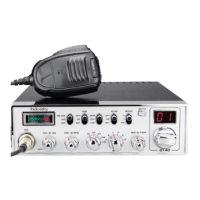
Do you have a question about the Radioddity QT40 and is the answer not in the manual?
| Brand | Radioddity |
|---|---|
| Model | QT40 |
| Category | Radio |
| Language | English |
Supports FM, AM, USB, LSB, and PA transmission modes.
Includes ALERT and FM receiver for 140-170MHz.
Separate settings for CTCSS/DCS for transmit and receive.
TX and RX Noise Reduction (NRC), NB/ANL function.
PC Programmable, Scrolling Frequency Display.
RF Gain, Microphone Gain, RF PWR Adjustment.
PWR/RX RSSI Signal Meter, SWR Readout and High SWR Protection.
FM Repeater Offset, +10kHz, Beep Level, TOT, HI-CUT, Busy Channel Lock.
TX Audio Monitor, LED Brightness, Voltage Protection, VOX, Roger Beep, Echo, NPC, SCAN.
Lists included accessories like radio, microphone, and mounting bracket.
Details optional accessories such as a USB Programming Cable.
Guidance on selecting a location and fixing the mounting bracket securely.
Instructions for connecting the microphone to the radio.
Requirements for antenna impedance and connection for optimal performance.
Specifies the 13.8V DC power supply requirement and warnings.
Procedure for replacing the 10A, 250V fuse and precautions.
Instructions for installing the microphone hanger without driver interference.
Guidance on connecting an optional 8 ohm external speaker.
Identifies and describes the functions of the front panel controls and indicators.
Identifies and describes the functions of the rear panel connectors and ports.
Details the controls on the microphone, including Channel Up/Down and PTT.
Instructions for turning the radio ON/OFF using the VOL control.
How to adjust Volume and Squelch levels for optimal audio.
Adjusting Mic Gain, RF Gain, and RF Power Output.
How to activate, control, and exit the SCAN mode.
Selecting operating modes (PA/FM/AM/USB/LSB) and frequency bands.
How to select channels and control frequencies.
Using microphone keys to display the working frequency.
Details the operation of slide switches for NB/ANL, NRC, MON, ECHO, and BAND.
Guide to accessing and adjusting radio functions via the menu system.
Lists and explains error codes (E1-E5) displayed during protection events.
Technical details including frequency range, channels, input voltage, and dimensions.
Details on power output, modulation, distortion, and carrier suppression.
Details on sensitivity, selectivity, image rejection, and squelch.